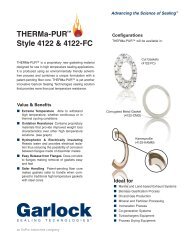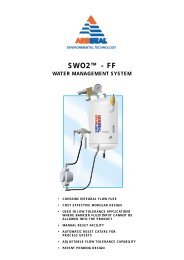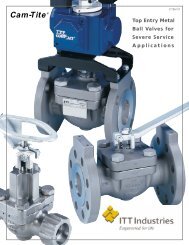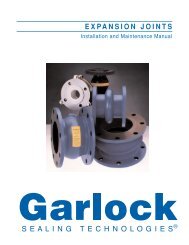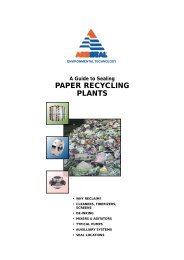automotive industry, pre-treatment & paint plants - AR Thomson Group
automotive industry, pre-treatment & paint plants - AR Thomson Group
automotive industry, pre-treatment & paint plants - AR Thomson Group
Create successful ePaper yourself
Turn your PDF publications into a flip-book with our unique Google optimized e-Paper software.
A Guide to Seals in the<br />
AUTOMOTIVE INDUSTRY,<br />
PRE-TREATMENT & PAINT PLANTS<br />
• THE VEHICLE PAINT<br />
PRODUCTION LINE<br />
• MECHANICAL SEAL SELECTION<br />
• CASE HISTORIES
AA U T O MM O T I VV EE<br />
AESSEAL ®<br />
AUTOMOTIVE<br />
INDUSTRY<br />
L-UK/US-AUTO-02<br />
IN 4379 -01/2002<br />
2<br />
AESSEAL plc Disclaimer<br />
EXCEPT AS EXPRESSLY PROVIDED HEREIN, AESSEAL plc SHALL NOT BE LIABLE FOR THE<br />
BREACH OF ANY W<strong>AR</strong>RANTY, EXPRESS OR IMPLIED, INCLUDING WITHOUT LIMITATION<br />
ANY W<strong>AR</strong>RANTY OF MERCHANTABILITY OF FITNESS FOR A P<strong>AR</strong>TICUL<strong>AR</strong> PURPOSE, OR<br />
FOR ANY DAMAGES OR OTHER LIABILITY <strong>AR</strong>ISING OUT OF OR IN CONJUNCTION WITH<br />
CUSTOMERS’ USE OF SUPPLIER PRODUCTS OR AESSEAL plc OR THE AUTHORISED<br />
DISTRIBUTOR DESIGNING, MANUFACTURING OR SELLING SUPPLIER PRODUCTS. IN NO<br />
EVENT SHALL AESSEAL plc BE LIABLE FOR DIRECT, SPECIAL, INCIDENTAL OR<br />
CONSEQUENTIAL DAMAGES, INCLUDING WITHOUT LIMITATION LOST SALES OR PROFIT,<br />
LOST PRODUCTION OR OUTPUT, INJURY TO PROPERTY OR REPUTATION, OR ANY OTHER<br />
DAMAGES WHETHER <strong>AR</strong>ISING IN CONTRACT OR TORT OR OTHERWISE (WHETHER OR<br />
NOT ATTRIBUTABLE TO THE FAULT OR NEGLIGENCE OF AESSEAL plc). UNDER NO<br />
CIRCUMSTANCES SHALL ANY RECOVERY OF ANY KIND AGAINST AESSEAL plc BE<br />
GREATER IN AMOUNT THAN THE PRICE OF THE PRODUCT TO THE END USER.<br />
This information corresponds to our current knowledge on the subject. It is offered solely to provide<br />
possible suggestions for your own experimentations. It is not intended, however, to substitute any testing<br />
you may need to conduct to determine for yourself the suitability of our products for your particular<br />
purposes. This information may be subject to revision as new knowledge and experience becomes<br />
available. Since we cannot anticipate all variations in actual end-use conditions, AESSEAL plc makes<br />
no warranties and assumes no liability in connection with any use of this information. Nothing in this<br />
publication is to be considered as a licence to operate under or a recommendation to infringe any patent<br />
right.<br />
ACKNOWLEDGMENTS<br />
We would like to thank Richard Smith, Sales Director, for his time<br />
and commitment in producing this document.<br />
We would also like to thank Jaguar Cars for the kind permission to<br />
use various pictures from their Halewood Production Plant.<br />
© Copyright 2002 AESSEAL plc All Rights Reserved.
CONTENTS<br />
Description Page<br />
Introduction . . . . . . . . . . . . . . . . . . . . . . . . . . . . . . . . . . . . . . . . . . .3<br />
Vehicle Paint Production Line . . . . . . . . . . . . . . . . . . . . . . . . . . . . .4<br />
Mechanical Seals . . . . . . . . . . . . . . . . . . . . . . . . . . . . . . . . . . . . . .6<br />
W2 Systems . . . . . . . . . . . . . . . . . . . . . . . . . . . . . . . . . . . . . . . . . .12<br />
Case Histories . . . . . . . . . . . . . . . . . . . . . . . . . . . . . . . . . . . . . . . .13<br />
Introduction<br />
The global demand for automobiles is increasing year on year. This demand is fuelling manufacturers to<br />
strive for higher quality in all aspects of <strong>automotive</strong> manufacture. As with most consumer driven<br />
industries, the quality and commercial attractiveness of the product are of paramount importance to any<br />
<strong>automotive</strong> manufacturer.<br />
Customer demand for increased corrosion protection and variation in the vehicles’ color specification<br />
dictate that the modern manufacturing line must be flexible and responsive to market changes.<br />
The appearance of the vehicle; its shape, style and bodywork finish can go a long way to selling a<br />
vehicle. Often, if these features are not aesthetically pleasing, the consumer will not even get inside to<br />
test the technical features. The quality of the vehicle <strong>paint</strong>work is, therefore, an essential part of the<br />
<strong>automotive</strong> production processes and one which a manufacturer ignores at his peril.<br />
In a typical car plant, more than 1000 cars are processed in any given day. This high volume and the<br />
most exacting of standards mean that a manufacturer must invest in a modern and efficient production<br />
line.<br />
Automotive manufacturers have taken up the challenge and now provide vehicles and products with<br />
many years of corrosion protection. Furthermore, they boast production lines which can accommodate<br />
changes in color specification from car to car.<br />
© Copyright 2002 AESSEAL plc All Rights Reserved.<br />
AA U T OO MM O T I VV EE<br />
AESSEAL ®<br />
AUTOMOTIVE<br />
INDUSTRY<br />
L-UK/US-AUTO-02<br />
IN 4379 - 01/2002<br />
3
AA U T O MM O T I VV EE<br />
AESSEAL ®<br />
AUTOMOTIVE<br />
INDUSTRY<br />
L-UK/US-AUTO-02<br />
IN 4379 - 01/2002<br />
4<br />
© Copyright 2002 AESSEAL plc All Rights Reserved.<br />
The Vehicle Paint<br />
Production Line<br />
The vehicle body is generally <strong>pre</strong>ssed and welded and transported to a <strong>pre</strong>-clean area. Here, high<br />
<strong>pre</strong>ssure water spray jets are directed at the body with the purpose of cleaning off dirt and debris from<br />
<strong>pre</strong>vious processes. This detritus can take many forms ranging from parts of components used in the<br />
production process, to operator refuse or items of clothing such as gloves.<br />
The vehicle is then transferred to the alkali dip rinse. The bodies are circulated through a series of dip<br />
tanks, which essentially degrease and clean the metal work. Each body is totally submerged in the<br />
caustic rinse, ensuring that no section is left untreated. Afterwards, the alkali dip excess fluid is drained<br />
from the vehicle body before the rinsing operation.<br />
During the dip rinse the full body of the vehicle is submerged in de-ionized water. This, like so many<br />
stages in the production process, is another cleaning operation. Next, the vehicle body goes onto the<br />
conditional spray. Spray pumps direct de-ionized water onto the vehicle body, generally at ambient<br />
temperatures before the phosphate operation.<br />
During the phosphate operation the body is completely submerged in a phosphate liquid which<br />
chemically etches the metal work and provides a layer of crystal on the surface of the steel. This enables<br />
the <strong>paint</strong> to ‘bite into’ the metal work for good adhesion.<br />
Occasionally, some <strong>plants</strong> opt for a partial phosphate dip, instead of a full phosphate dip, which is<br />
complemented by spray jets directing phosphate solution onto the roof of the vehicle. It is not<br />
uncommon to see many re-iterations of the same process, i.e. cleaning, etching, rinsing etc. This is a<br />
safeguard against wasted efforts further along the production line.<br />
The care and attention required in the <strong>pre</strong>-<strong>treatment</strong> makes this one of the most critical elements in the<br />
plant in obtaining a good <strong>paint</strong> finish.<br />
The phosphate system is sometimes referred to as "the bond". This is the part of the plant which bonds<br />
the <strong>paint</strong> to the steel body frame.<br />
Depending on the type of plant, a hot blower is sometimes employed. If the body is going into storage,<br />
the hot blower is commonly encountered. If the plant is a continuous production line then this stage is<br />
often omitted.<br />
From the phosphate operation, the body of the vehicle is transported to the <strong>pre</strong>paration deck and then<br />
onto the ELPO (Electro Coat Paint Operation), commonly referred to as the E-Coat, a water based<br />
<strong>paint</strong>ing operation. During the ELPO process, the body is immersed or dipped into electro-coat <strong>paint</strong>.<br />
The whole body is charged with electricity (similar to a plating process). The <strong>paint</strong> sticks to the body as<br />
the body is charged, as it effectively becomes a cathode whilst the <strong>paint</strong> becomes an anode.<br />
After this process the body is transported to an UF-dip (Ultra Filtrate) and then onto a UF-spray.<br />
Lastly the vehicle body goes through a DI-spray and DI-dip which is effectively a cleaning spray<br />
operation, then into an oven for approximately 20 minutes. Afterwards the body is transferred to the<br />
finishing plant where it is masked, PVC (Uniseal) sprayed, de-masked and sent to the sealer-deck for<br />
sealant to be applied between the seams and under the bonnet of the vehicle.
A Typical Vehicle Paint Production Line<br />
The body is then stone chipped, which is the heavy black <strong>paint</strong> finish underneath the car, and then sent<br />
to the primer booths for either manual or robotic spraying. It is here where the flexibility of the plant is<br />
realized as atomizing bells provide the flexibility to rapidly change the color of a vehicle body in the<br />
production line.<br />
After the primer booths, the body is then transported to the ovens, then onto the color booths, where it<br />
is once again manually or robotically sprayed using atomizing bells.<br />
After a last oven operation the body is then sent to the trim/assembly area where the finished product<br />
is realized.<br />
© Copyright 2002 AESSEAL plc All Rights Reserved.<br />
AA U T OO MM O T I VV EE<br />
AESSEAL ® AESSEAL ®<br />
AUTOMOTIVE<br />
INDUSTRY<br />
L-UK/US-AUTO-02<br />
IN 4379 - 01/2002 07/2001<br />
5
AA U T O MM O T I VV EE<br />
AESSEAL ®<br />
AUTOMOTIVE<br />
INDUSTRY<br />
L-UK/US-AUTO-02<br />
IN 4379 - 01/2002<br />
6<br />
© Copyright 2002 AESSEAL plc All Rights Reserved.<br />
Mechanical Seals<br />
Mechanical seals are found in many positions in the plant. This is due to the fact that the <strong>paint</strong> plant<br />
uses massive volumes of liquid, mainly during the <strong>pre</strong>-<strong>treatment</strong> operations. Centrifugal pumps and<br />
mechanical seals, therefore, play an important part in the efficient running of a modern <strong>automotive</strong> <strong>paint</strong><br />
plant. The following text indicates the seal standardization for the respective sections of the production<br />
line.<br />
Important: Silicone grease can contaminate the whole <strong>paint</strong>ing<br />
system, if used during the seal assembly. The <strong>pre</strong>sence of<br />
silicone grease can <strong>pre</strong>vent <strong>paint</strong> adhesion to the vehicle body.<br />
It is, therefore, essential that it should never be used. See Z895<br />
grease for a suitable replacement.<br />
Main AESSEAL ® seals used in <strong>paint</strong> <strong>plants</strong><br />
CURC - Single Seal<br />
CDSA - Double Seal<br />
DMSF - Double Seal
Sealing at the "Pre-clean" Stage<br />
Pre-clean is conducted by one of two methods:<br />
Deluge: High production volume operating at low <strong>pre</strong>ssure.<br />
Knock-off: High <strong>pre</strong>ssure sprays (Knock-off sprays), direct water towards the<br />
<strong>pre</strong>ssed and welded vehicle bodies.<br />
Mechanical seals may be found on the high-<strong>pre</strong>ssure centrifugal pumps, which feed the sprays. These<br />
can be a multi-staged arrangement, or a bank of single stage pumps, which go from suction to<br />
discharge of the next pump in the line. Knock-off is generally set at (30 - 45 psi) 2-3 bar on single<br />
centrifugal pumps, used to throttle back the spray <strong>pre</strong>ssure, so that it is not too high.<br />
Typically a hydrocyclone separator removes the lightweight contraries.<br />
Seal Standardization<br />
Seal Type: CURC single cartridge seal with Z895 grease<br />
Seal Faces: Car/TC<br />
Seal Elastomers: Viton ®<br />
Seal System: API Plan 13<br />
Knock-off is sometimes "soapy" and can contain heavy deposits of swarf. Depending on the pump<br />
specification and duty, CDSA double seals TC/TC//Chrox/Car (Z895) with SSE10 W2 support<br />
system, are sometimes <strong>pre</strong>ferred.<br />
Sealing at the "Alkali (Caustic) Dip/Rinse" Stage<br />
Mechanical seals may be found on the circulation centrifugal pumps, which re-circulate the dip tanks.<br />
Note: Caustic is hazardous, therefore, double seals are <strong>pre</strong>ferred.<br />
Seal Standardization<br />
Seal Type: CDSA single cartridge seal with Z895 grease<br />
Seal Faces: TC/TC//Chrox/Car<br />
Seal Elastomers: Aflas ®<br />
Seal System: SSE10 W2<br />
Sealing the "Conditioner Spray"<br />
Mechanical seals may be found on the centrifugal pumps, which feed the sprays. Soilds can be <strong>pre</strong>sent<br />
depending on the conditioner additive used (Titanium).<br />
Seal Standardization<br />
Seal Type: CDSA Double cartridge seal with Z895 grease<br />
Seal Faces: TC/TC//Chrox/Car<br />
Seal Elastomers: Viton ®<br />
Seal System: API Plan 13<br />
© Copyright 2002 AESSEAL plc All Rights Reserved.<br />
AA U T OO MM O T I VV EE<br />
AESSEAL ®<br />
AUTOMOTIVE<br />
INDUSTRY<br />
L-UK/US-AUTO-02<br />
IN 4379 - 01/2002<br />
7
AA U T O MM O T I VV EE<br />
AESSEAL ®<br />
AUTOMOTIVE<br />
INDUSTRY<br />
L-UK/US-AUTO-02<br />
IN 4379 - 01/2002<br />
8<br />
Sealing "Phosphate Dipping"<br />
During the phosphate dip, the vehicle body is chemically etched, providing a layer of crystal on the<br />
surface of the steel, which provides a "tooth" for the <strong>paint</strong> to adhere to. Mechanical seals may be found<br />
on the phosphate circulation pumps, which circulate the liquid around the dip tank or on phosphate<br />
sludge pumps, which take the sludge away to the filtering process.<br />
Phosphate contains DI-water and it is undesirable to leak vast quantities, however, it is difficult to seal.<br />
If one can seal the "phosphate" process, one can seal the whole <strong>paint</strong> plant. The key to successful<br />
sealing is to keep the phosphate moving and avoid dead areas in the pipework where "growth" can<br />
occur.<br />
Sealing "E Coat" at the Halewood jaguar plant.<br />
Seal Standardization<br />
Seal Type: CDSA double cartridge seal with Z895 grease<br />
Seal Faces: SiC/SiC//SiC/Car<br />
Seal Elastomers: Viton ®<br />
Seal System: SSE10 W2 or water ring main<br />
Barrier Fluid: DI or plant water<br />
© Copyright 2002 AESSEAL plc All Rights Reserved.
Sealing the Pasivator Process<br />
Mechanical seals will be found on the centrifugal recirculation pumps. Solids can be <strong>pre</strong>sent depending<br />
on the conditioner additive used (Zirconium).<br />
Seal Standardization<br />
Seal Type: CDSA double cartridge seal with Z895 grease<br />
Seal Faces: TC/TC//Chrox/Car<br />
Seal Elastomers: Viton ®<br />
Seal System: SSE10 W2<br />
Barrier Fluid: Ultra filtrate/ Di water<br />
Sealing the "ELPO Dip/Plating or E Coat" Process<br />
Mechanical seals may be found on the circulation, and centrifugal pumps.<br />
Seal Standardization<br />
Seal Type: DMSF double cartridge seal with Z895 grease<br />
Seal Faces: TC/TC//TC/Car<br />
Seal Elastomers: Viton ®<br />
Seal System: SSE10 W2<br />
Barrier Fluid: Ultra filtrate/ Di water (consult AESSEAL ® on application).<br />
Alternative<br />
Seal Type: CDSA double cartridge seal with<br />
Z895 grease<br />
Seal Faces: TC/TC//TC/Car<br />
Seal Elastomers: Viton ®<br />
Seal System: Water ring main<br />
Barrier Fluid: DI or Ultra filtrate<br />
Sealing the "UF-Dip" (Ultra Filtrate)<br />
The Ultra Filtrate dip consists of DI mineralized water and generally is found with bits of <strong>paint</strong> in it.<br />
Mechanical seals may be found on the centrifugal circulation and filter pumps.<br />
Problems arise should the Ultra Filtrate vaporize between the seal faces and leave <strong>paint</strong> residue behind.<br />
This sticks the seal faces together which can break Silicon Carbide seal faces on equipment startup.<br />
Seal Standardization<br />
Seal Type: CURC single cartridge seal with Z895 grease<br />
Seal Faces: TC/TC<br />
Seal Elastomers: Viton ®<br />
Seal System: API Plan 13<br />
*Optional: CDSA TC/TC//Chrox/Car-Viton ® (Z895) with SSE10 W2 seal support system.<br />
© Copyright 2002 AESSEAL plc All Rights Reserved.<br />
AA U T OO MM O T I VV EE<br />
AESSEAL ®<br />
AUTOMOTIVE<br />
INDUSTRY<br />
L-UK/US-AUTO-02<br />
IN 4379 - 01/2002<br />
9
AA U T O MM O T I VV EE<br />
AESSEAL ®<br />
AUTOMOTIVE<br />
INDUSTRY<br />
L-UK/US-AUTO-02<br />
IN 4379 - 01/2002<br />
10<br />
Sealing the Anolite<br />
This is a conductive fluid (Citric Acid & Demin) that is circulated through the anodes in the E Coat tanks.<br />
Seal Standardization<br />
Seal Type: CURC single cartridge seal with Z895 grease<br />
Seal Faces: Car/SiC<br />
Seal Elastomers: Viton ®<br />
Seal System: API Plan 13<br />
Coagulation/Sludge Plant<br />
Air is continuously blowing through the booths to the water curtain, residing either behind or underneath<br />
the booth.<br />
The water "river" takes all the overspray <strong>paint</strong> particles away, into the coagulation plant.<br />
The <strong>paint</strong> particles may be removed from the water by one of several methods:<br />
• The chemical approach: Chemicals are injected into the water, which makes the <strong>paint</strong> molecules stick<br />
together and sink. Conveyers or PCP pumps then mechanically move the <strong>paint</strong> sludge to a skip.<br />
• The aeration system: Air is added to the water causing the <strong>paint</strong> molecules to stick to the surface of<br />
the bubbles, which then float to the top of the water. The <strong>paint</strong> sludge is then skimmed off the surface<br />
of the water and transported to skips.<br />
• The mechanical approach: Water is pumped through filters, which screen the <strong>paint</strong> molecules,<br />
separating them from the water. The filters are then opened and the <strong>paint</strong> sludge is taken to skips.<br />
© Copyright 2002 AESSEAL plc All Rights Reserved.
Seal Standardization<br />
Seal Type: CDSA double seal with Z895 grease<br />
(CDSA PCP for Progressing Cavity Pumps)<br />
Seal Faces: TC/TC//Chrox/Car<br />
Seal Elastomers: Viton ®<br />
Seal System: SSE10 W2<br />
Barrier Fluid: Plant water<br />
*Optional: CURC TC/TC-Viton ® with town water flush at 25 psi.<br />
Finished body shells ready for assembly at the Halewood Jaguar plant.<br />
© Copyright 2002 AESSEAL plc All Rights Reserved.<br />
AA U T OO MM O T I VV EE<br />
AESSEAL ®<br />
AUTOMOTIVE<br />
INDUSTRY<br />
L-UK/US-AUTO-02<br />
IN 4379 - 01/2002<br />
11
AA U T O MM O T I VV EE<br />
AESSEAL ®<br />
AUTOMOTIVE<br />
INDUSTRY<br />
L-UK/US-AUTO-02<br />
IN 4379 - 01/2002<br />
12<br />
Water Supply<br />
Regulator<br />
Spring<br />
Loaded<br />
Non-Return<br />
Valve Flow<br />
Indicator<br />
Inline Filter<br />
Option<br />
Ball<br />
Valve<br />
3-Way Valve<br />
Drain Hose<br />
Pressure<br />
Gauge<br />
© Copyright 2002 AESSEAL plc All Rights Reserved.<br />
W2 SYSTEMS<br />
SSE10 SYSTEM W2 STAND<strong>AR</strong>D WATER RETENTION VESSEL CODE VSE/SW02<br />
1 Micron<br />
Inline Filter<br />
STAINLESS STEEL VESSEL<br />
MIN FLUID<br />
LEVEL<br />
12mm (1/2”)<br />
Hose Kit<br />
MAX 2 METER<br />
MIN LIQUID<br />
LEVEL<br />
DRAIN<br />
SEAL<br />
QUENCH<br />
Air Vent<br />
Valve<br />
MAX 1 METER<br />
Side<br />
View<br />
Vessel<br />
Peak<br />
Temperature<br />
Current<br />
Temperature
CASE No. 843H<br />
In a car plant in the U.K., a 65mm CDSA<br />
seal was fitted to a Euramo Salmson<br />
centrifugal pump, model number M4/C4. The<br />
duty being pumped was phosphate<br />
recirculation operating at a shaft speed of<br />
1440 rpm with inlet <strong>pre</strong>ssure being 5 psi (0.3<br />
bar) and outlet <strong>pre</strong>ssure being 20 psi (1.4<br />
bar). The seal faces were TC/TC//CRO2/C<br />
with Viton elastomers and 316L wetted parts.<br />
The mechanical seal operated with a<br />
SSE10 W2 system pumping town water at<br />
25 psi (1.7 bar). The CDSA and W2 system<br />
lasted 3.5 years due to the seal having to be<br />
removed because the pump failed. The<br />
customer was <strong>pre</strong>viously using a double<br />
back to back and sleeve with quench to drain<br />
which lasted less than 12 months.<br />
CASE No. 845H<br />
In a car plant in the U.K., a 48mm CDSA<br />
seal was fitted to a Tangie pump, model<br />
number HB-125-250. The duty being<br />
pumped was <strong>paint</strong> recirculation operating at<br />
a temperature of 104 - 122ºF (40 - 50°C). The<br />
seal faces were TC/TC//CRO2/C with Viton ®<br />
elastomers and 316L wetted parts. The<br />
mechanical seal operated with a SSE10<br />
W2 system and lasted for 5 years.<br />
The customer was <strong>pre</strong>viously using PTFE<br />
wedge back to back seals with Car/Cer seal<br />
faces, with a stuffing box adapter ring and<br />
new impeller spacer being used. The average<br />
life was less than 12 months.<br />
See Z895 for further information.<br />
CASE No. 846H<br />
In a car plant in the U.K., a 50mm CDSA<br />
seal was fitted to a Euramo Salmson<br />
centrifugal pump model number 125/100/315<br />
M3. The duty being pumped was electro coat<br />
operating at a temperature of 86ºF (30°C)<br />
with a shaft speed of 1440 rpm with an inlet<br />
<strong>pre</strong>ssure of 25 psi (1.7 bar) and outlet<br />
<strong>pre</strong>ssure of 90 psi (6.2 bar). The seal faces<br />
were TC/TC//CRO2/C with Viton ® elastomers.<br />
The customer was <strong>pre</strong>viously using a back to<br />
back with a sleeve. This was difficult to install<br />
and service life was poor. They also required<br />
a new sleeve. The CDSA was installed<br />
Case Histories<br />
directly onto the shaft and service life was<br />
more than 4 years. Stores now only need to<br />
stock a single part number and not the 5<br />
parts of a back to back assembly.<br />
1 - Sleeve<br />
2 - Inboard Seal<br />
3 - Inboard Stationary<br />
4 - Outboard Seal<br />
5 - Outboard Stationary<br />
CASE No. 847H<br />
In a car plant in the U.K., a 48mm CDSA<br />
seal was fitted to a Tangie pump, model<br />
number HB 125-250. The duty being pumped<br />
was electro coat operating at a temperature<br />
of 104ºF (40°C) with a shaft speed of 1450<br />
rpm with an inlet <strong>pre</strong>ssure of 15 psi (1 bar)<br />
and outlet <strong>pre</strong>ssure 37 psi (2.5 bar). The seal<br />
faces were TC/TC//CRO2/C with Viton ®<br />
elastomers and 316L wetted parts. The<br />
mechanical seal operated with a SSE10<br />
W2 system for 4 years.<br />
The customer was <strong>pre</strong>viously using back to<br />
back PTFE wedge seals with a gland seal<br />
circulation system, with a stuffing box<br />
adapter ring and new impeller spacer being<br />
used.<br />
See Z895 for further information.<br />
CASE No. 848H<br />
In a car plant in the U.K., a 55mm CURC<br />
seal (with API Plan 11) was fitted to an IDP<br />
centrifugal pump, bearing frame 3. The duty<br />
being pumped was Ultra Filtrate operating at<br />
ambient temperature with a shaft speed of<br />
1550 rpm with an inlet <strong>pre</strong>ssure of 10 psi (0.7<br />
bar) and outlet <strong>pre</strong>ssure 30 psi (2 bar). The<br />
seal faces were TC/TC with Viton ® elastomers<br />
and 316L wetted parts. The mechanical seal<br />
operated with a SSE10 W2 system<br />
pumping de-min water barrier at 22 psi (1.5<br />
bar).<br />
The CURC seal (which lasted 3 years) was<br />
fitted to a new pump, replacing a noncartridge,<br />
TC/TC face seal, which only lasted<br />
6 months.<br />
© Copyright 2002 AESSEAL plc All Rights Reserved.<br />
AA U T OO MM O T I VV EE<br />
AESSEAL ®<br />
AUTOMOTIVE<br />
INDUSTRY<br />
L-UK/US-AUTO-02<br />
IN 4379 - 01/2002<br />
13
AA U T O MM O T I VV EE<br />
AESSEAL ®<br />
AUTOMOTIVE<br />
INDUSTRY<br />
L-UK/US-AUTO-02<br />
IN 4379 - 01/2002<br />
14<br />
CASE No. 849H<br />
In a car plant in the U.K., a 65mm CDSA<br />
seal was fitted to an IDP centrifugal pump,<br />
model Frame 4. The duty being pumped was<br />
electro <strong>paint</strong> operating with a shaft speed of<br />
1440 rpm, with an inlet <strong>pre</strong>ssure of 25 psi (1.7<br />
bar) and outlet <strong>pre</strong>ssure 90 psi (6.2 bar). The<br />
seal faces were TC/TC//CRO2/C with Viton ®<br />
elastomers and 316L wetted parts. The<br />
mechanical seal operated with an SSE10<br />
W2 system.<br />
The customer's <strong>pre</strong>vious seal’s life was less<br />
than 12 months. The CDSA life was more<br />
than 3 years.<br />
See Z895 for further details.<br />
CASE No. 850H<br />
In a car plant in the U.K., a 50mm CURC<br />
seal was fitted to a pump. The duty being<br />
pumped was effluent operating at an ambient<br />
temperature with a shaft speed of 1450 rpm<br />
with an inlet <strong>pre</strong>ssure of 15 psi (1 bar) and<br />
outlet <strong>pre</strong>ssure 44 psi (3 bar). The seal faces<br />
were TC/TC with Viton ® elastomers and 316L<br />
wetted parts.<br />
The customer has converted from packing.<br />
See Z895 for further information.<br />
CASE No. 851H<br />
In a car plant in the U.K., a 48mm CDSA<br />
seal was fitted to a Jeumont Schneider,<br />
model number MEN/100/300. The duty being<br />
pumped was coagulant operating at a<br />
temperature of 86ºF (30°C) with a shaft speed<br />
of 1440 rpm. Inlet <strong>pre</strong>ssure was 10 psi (0.7<br />
bar) and outlet <strong>pre</strong>ssure 75 psi (5.2 bar),<br />
quench being <strong>pre</strong>ssurized at 73 psi (5 bar).<br />
The customer was <strong>pre</strong>viously using a hard<br />
faced single spring seal with a life of 10<br />
minutes. The CDSA seal lasted more than<br />
5 years.<br />
CASE No. 852H<br />
In a car plant in the U.K., a 2.125" CDSA<br />
seal was fitted to a Tangie pump, model<br />
number HB 150-315. The duty being pumped<br />
was <strong>paint</strong> operating at a temperature of<br />
122ºF (50°C) with an inlet <strong>pre</strong>ssure of 15 psi<br />
(1 bar) and outlet <strong>pre</strong>ssure 37 psi (2.5 bar).<br />
The seal faces were TC/TC//CRO2/C with<br />
© Copyright 2002 AESSEAL plc All Rights Reserved.<br />
Viton ® elastomers and 316L wetted parts.<br />
The customer was <strong>pre</strong>viously using a back to<br />
back single spring assembly.<br />
A small amount of modification is required:<br />
1. Remove existing seal housing.<br />
2. Reduce PCD of seal housing studs.<br />
3. Manufacture adapter ring for stuffing box.<br />
4. Manufacture a new impeller spacer.<br />
See Z895 for further information.<br />
CASE No. 1316J<br />
In an <strong>automotive</strong> <strong>paint</strong> plant in the North West<br />
of England, AESSEAL ® supplied 10 off 50mm<br />
DMSF and bespoke SSE10 W2 Systems<br />
via an OEM. The pump units were End<br />
Suction Isoglide Pumps model Ref HL-150-<br />
125-315 and are used to circulate<br />
Electrocoat <strong>paint</strong> around dip tanks. The seal<br />
face combination was TC/TC/TC/C/V Z895.<br />
The barrier fluid media was UltraFiltrate and<br />
the application details are as follows:<br />
Pump Suction Pressure - 1 Bar (g)<br />
Pump Delivery Pressure - 3 Bar (g)<br />
Pump Speed - 1450 rpm<br />
Bulk Temperature - 30 to 40 Deg C<br />
Barrier fluid <strong>pre</strong>ssure is 4 Bar (g) and the<br />
SSE10 systems are energized from a<br />
manifold <strong>pre</strong>ssurized by a small Air Operated<br />
Piston Pump.<br />
The pumps and seal were installed in July<br />
2000 and have been running trouble free ever<br />
since.<br />
Important: Silicone grease can<br />
contaminate the whole <strong>paint</strong>ing<br />
system, if used during the seal<br />
assembly. The <strong>pre</strong>sence of<br />
silicone grease can <strong>pre</strong>vent<br />
<strong>paint</strong> adhesion to the vehicle<br />
body. It is, therefore, essential<br />
that it should never be used.<br />
See Z895 grease for a suitable<br />
replacement.
NOTE:<br />
Due to AESSEAL’s policy of continuous improvement the following seal types have been<br />
upgraded:<br />
SCI upgraded to SCUSI<br />
CSAI upgraded to CURC<br />
CAPI upgraded to CURC<br />
CAPO upgraded to CRCO<br />
CMDS upgraded to CDSA & DMSF<br />
The original products evolved into more modern seals which were designed to enhance<br />
application performance. The product model reference in the case study is for the most<br />
modern design, even though at the time of installation the actual installation was the<br />
<strong>pre</strong>decessor model.<br />
All information featured in these case histories has been obtained directly from Plant<br />
Engineers.<br />
Although we have confidence in the accuracy of this information, it is not offered as a<br />
guarantee for seals manufactured by AESSEAL ® .<br />
Any prospective user of our product should verify the information stated to their own<br />
satisfaction.<br />
Further information is available on all the case histories contained in this booklet upon<br />
request.<br />
Issue ‘A’ on a case history refers to information which was current on the 31st. January,<br />
1989.<br />
Issue ‘B’ refers to information which was current on 31st. January, 1990.<br />
Issue ‘C’ refers to information which was current on 31st. January, 1991.<br />
Issue ‘D’ refers to information which was current on 31st. January, 1992.<br />
Issue ‘E’ refers to information which was current on 31st. January, 1993.<br />
Issue ‘F’ refers to information which was current on 31st. January, 1995.<br />
Issue ‘G’ refers to information which was current on 31st. January, 1998.<br />
Issue ‘H’ refers to information which was current on 31st. October, 1999.<br />
Issue ‘I’ refers to information which was current on 31st. March, 2000.<br />
Issue ‘J’ refers to information which was current on 31st. November, 2000.<br />
Where the statement 'The seals are still working' is made, this means that the customer is<br />
or was still using AESSEAL ® mechanical seals at the time the case history was updated; as<br />
denoted by either:<br />
Issue ‘A’, Issue ‘B’, Issue ‘C’, Issue ‘D’, Issue ‘E’, Issue ‘F’, Issue ‘G’, Issue ‘H’, Issue ‘I’ or<br />
Issue ‘J’.<br />
For more detailed information, please contact our Applications Department.<br />
© Copyright 2002 AESSEAL plc All Rights Reserved.<br />
AA U T OO MM O T I VV EE<br />
AESSEAL ®<br />
AUTOMOTIVE<br />
INDUSTRY<br />
L-UK/US-AUTO-02<br />
IN 4379 - 01/2002<br />
15
THIS DOCUMENT IS DESIGNED TO PROVIDE DIMENSIONAL INFORMATION AND AN INDICATION OF AVAILABILITY.<br />
FOR FURTHER INFORMATION AND SAFE OPERATING LIMITS CONTACT OUR TECHNICAL SPECIALISTS AT THE LOCATIONS BELOW.<br />
AESSEAL plc<br />
Mill Close<br />
Templeborough<br />
Rotherham<br />
S60 1BZ<br />
United Kingdom<br />
Telephone: +44 (0) 1709 369966<br />
Fax: +44 (0) 1709 720788<br />
E-mail: seals@aesseal.com<br />
Internet: http://www.aesseal.com<br />
© Copyright AESSEAL plc 2002<br />
All Rights Reserved<br />
AES / DOC / IN 4379 01/2002<br />
AESSEAL plc, Rotherham, U.K. Telephone: +44 (0) 1709 369966<br />
AESSEAL plc, Derby, U.K. Telephone: +44 (0) 1332 366738<br />
AESSEAL plc, Peterborough, U.K. Telephone: +44 (0) 1733 230787<br />
AESSEAL plc, Scotland, U.K. Telephone: +44 (0) 1698 849808<br />
AESSEAL plc, Middlesbrough, U.K. Telephone: +44 (0) 1642 245744<br />
AESSEAL plc, Essex, U.K. Telephone: +44 (0) 1708 256600<br />
AESSEAL plc, Pontypridd, U.K. Telephone: +44 (0) 1443 844330<br />
AESSEAL (MCK) Ltd., Lisburn, U.K. Telephone: +44 (0) 28 9266 9966<br />
AESSEAL (MCK) Ltd., Co. Cork, Ireland. Telephone: +353 (0) 214 633477<br />
AESSEAL Inc., Knoxville, Tennessee, USA. Telephone: +1 865 531 0192<br />
AESSEAL Inc., Seneca Falls, New York, USA. Telephone: +1 315 568 4706<br />
AESSEAL Inc., Kingsport, Tennessee, USA. Telephone: +1 423 224 7573<br />
AESSEAL ESP LLC, Cedar Rapids, Iowa, USA. Telephone: +1 319 393 4310<br />
AESSEAL Deutschland AG. Telephone: +49 (0) 60 74 881293<br />
AESSEAL Italia SRL. Telephone: +39 (0) 33 197 0556<br />
AESSEAL Pty Ltd., Gauteng, South Africa. Telephone: +27 (0) 11 466 6500<br />
AESSEAL Pty Ltd., Confluid Branch, Amanzimtoti, South Africa. Telephone: +27 (0) 31 903 5438<br />
AESSEAL Malaysia SDN. BHD. Telephone: +603 8062 1233<br />
AESSEAL Nederland. Telephone: +31 (0) 76 564 9292<br />
AESSEAL Ibérica S.L. Telephone: +34 977 55 43 30<br />
AESSEAL Danmark, Køge, Denmark. Telephone: +45 56 64 14 00<br />
AESSEAL France S.A.R.L. Telephone: +33 (0) 3 2017 2850<br />
AESSEAL Turkiye, Istanbul, Turkey. Telephone: +90 (0) 212 237 40 47<br />
AESSEAL Canada Inc. Telephone: +1 807 624 2727<br />
AESSEAL China Ltd. Telephone: +86 574 8770 1888<br />
WINNER OF THE<br />
NATWEST<br />
SUNDAY TIMES<br />
COMPANY OF<br />
TOMORROW<br />
AW<strong>AR</strong>D<br />
The AESSEAL ® <strong>Group</strong> of Companies<br />
Distributed by:<br />
CURC, CDSA, DMSF and SSE10 are Trademarks of AESSEAL plc<br />
Registered Trademarks: AESSEAL ® - AESSEAL plc<br />
Viton ® - DuPont Dow Elastomers. Aflas ® - Asahi Glass Co.<br />
USE DOUBLE MECHANICAL SEALS<br />
WITH HAZ<strong>AR</strong>DOUS PRODUCTS.<br />
ALWAYS TAKE SAFETY<br />
PRECAUTIONS:<br />
• GU<strong>AR</strong>D YOUR EQUIPMENT<br />
• WE<strong>AR</strong> PROTECTIVE CLOTHING<br />
W<strong>AR</strong>NING<br />
USA Sales & Technical advice:<br />
AESSEAL Inc.<br />
10231 Cogdill Road<br />
Suite 105<br />
Knoxville, TN 37932<br />
USA<br />
Telephone: 865 531 0192<br />
Fax: 865 531 0571<br />
ALL SIZES <strong>AR</strong>E SUBJECT TO MANUFACTURING TOLERANCES.<br />
WE RESERVE THE RIGHT TO MODIFY SPECIFICATIONS AT ANY TIME.<br />
Reference Issue • L - UK/US - AUTO - 02



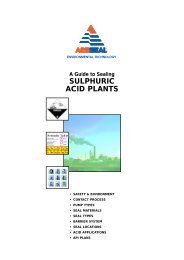
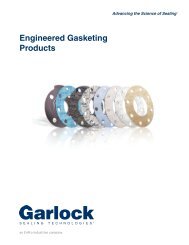
![VCS Flange Gasket [1.03 MB] - AR Thomson Group](https://img.yumpu.com/12044617/1/190x245/vcs-flange-gasket-103-mb-ar-thomson-group.jpg?quality=85)

![PGE Flange Gasket Product Brochure [1.04 MB] - AR Thomson Group](https://img.yumpu.com/12044595/1/190x245/pge-flange-gasket-product-brochure-104-mb-ar-thomson-group.jpg?quality=85)
